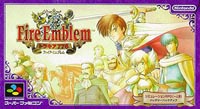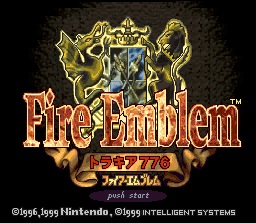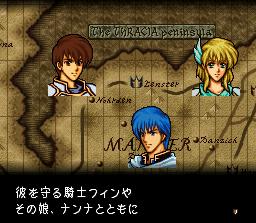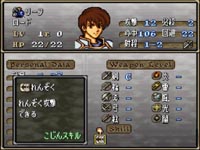
Title: Fire Emblem: Thracia 776
English Name: Fire Emblem: Thracia 776
Main Character: Leaf
Release Date: September 1st, 1999
Introduction
Part 1: Intelligent Systems
Part 2: Dark Dragon and Sword of Light
Part 3: Fire Emblem Gaiden
Part 4: Mystery of the Emblem
Part 5: Genealogy of the Holy War
Part 6: Thracia 776
Part 7: Sword of Seals
Part 8: Blazing Sword
Part 9: Fire Emblem Tradition
Part 10: BS, The Anime, The Card Game, and the Future
Originally written for
in January 2004
by Derek Miller


Genealogy of the Holy War was released in the same year as the Nintendo 64 so most people assumed the next Fire Emblem would be a Nintendo 64 game. Things didn't quite turn out that way. For some reason Nintendo decided to release Fire Emblem: Thracia 776 for Super Famicom instead of Nintendo 64 in September of 1999. Nintendo didn't release the game on a standard Super Famicom cartridge, however. Nintendo had started a system that allowed gamers to buy blank Super Famicom cartridges, which they could use at Lawson stores in Japan to download almost any Super Famicom game. The few games that wouldn't work with this system were those with special chips in the cartridges such as Star Fox and Super Mario World 2. These catridges, known as Super Famicom Nintendo Power carts, allowed Nintendo to continue selling Super Famicom games long after production of Super Famicom cartridges ended, and the program was in place until late 2002. However, this didn't lead to great sales of Thracia 776 so the game was released as a standard Super Famicom cartridge in January of 2000, giving it the distinction of being the last Super Famicom game to be released, but also the dishonor of being the worst selling Fire Emblem game. This doesn't mean the game was bad, however, it was just released at the wrong time and on the wrong console.
 Thracia 776 takes place on the same continent as Genealogy of the Holy War, Jugdral, and in it Prince Leaf of the kingdom of Lenstar attempts to protect his kingdom from the invading forces of Thracia. The game takes place between chapters five and six of Genealogy of the Holy War, and contains so many spoilers of that game that there isn't much that can be said about the story of Thracia 776 without spoiling Genealogy of the Holy War. Thracia 776 also overlaps a little with chapter seven of Genealogy, and ends where chapter eight of that game begins. If you are interested in playing the Fire Emblem games you should not even think of playing this game before Genealogy. The game is full of cameos and spoilers from Genealogy of the Holy War, and you probably wouldn't even understand a lot of it because of that.
Thracia 776 takes place on the same continent as Genealogy of the Holy War, Jugdral, and in it Prince Leaf of the kingdom of Lenstar attempts to protect his kingdom from the invading forces of Thracia. The game takes place between chapters five and six of Genealogy of the Holy War, and contains so many spoilers of that game that there isn't much that can be said about the story of Thracia 776 without spoiling Genealogy of the Holy War. Thracia 776 also overlaps a little with chapter seven of Genealogy, and ends where chapter eight of that game begins. If you are interested in playing the Fire Emblem games you should not even think of playing this game before Genealogy. The game is full of cameos and spoilers from Genealogy of the Holy War, and you probably wouldn't even understand a lot of it because of that.
 The personal skills of Genealogy return in a tweaked form, but Thracia 776 added a lot more to the gameplay of the Fire Emblem series. The most important thing it added was new missions instead of the usual seize the throne/castle missions. Of course, the seize missions made up the vast majority of the missions in the game, but three new types of missions were thrown into the mix. The first was escape missions, and they contributed to the immense difficulty of Thracia 776. These missions contained a red arrow that you must get Prince Leaf to in order to win. It wasn't nearly as easy as it sounded. For one, there were usually an incredible amount of enemies chasing after you that you must fend off along with a number of enemies guarding the area of your escape. The enemy always received reinforcements every turn or so, so there was no way for you to defeat all of them. The horrible catch of these missions was that any units who did not get to the arrow before Leaf were considered left behind and would be lost. These missions led to the jump in the sales of Aspirin in Japan during 1999 and 2000. The defend missions reversed your normal role in the game and had Leaf and his troops defending a throne, temple, or other place or person of importance while the enemy tried to break through. The enemy had unlimited reinforcements, but if you could hold out for a certain number of turns you would win the mission. The final new mission type was a mixture of the first two new ones. In it you had to capture a castle and then defend it until all of your troops could escape the map. All of these missions provided a unique twist on the strategy of Fire Emblem, and the defend missions are now a staple of the series. Thracia 776 also introduced fog of war to the Fire Emblem series that was used during night battles. The missions, cleverly designed maps, and incredibly intelligent AI contributed to making Thracia 776 the most difficult Fire Emblem yet.
The personal skills of Genealogy return in a tweaked form, but Thracia 776 added a lot more to the gameplay of the Fire Emblem series. The most important thing it added was new missions instead of the usual seize the throne/castle missions. Of course, the seize missions made up the vast majority of the missions in the game, but three new types of missions were thrown into the mix. The first was escape missions, and they contributed to the immense difficulty of Thracia 776. These missions contained a red arrow that you must get Prince Leaf to in order to win. It wasn't nearly as easy as it sounded. For one, there were usually an incredible amount of enemies chasing after you that you must fend off along with a number of enemies guarding the area of your escape. The enemy always received reinforcements every turn or so, so there was no way for you to defeat all of them. The horrible catch of these missions was that any units who did not get to the arrow before Leaf were considered left behind and would be lost. These missions led to the jump in the sales of Aspirin in Japan during 1999 and 2000. The defend missions reversed your normal role in the game and had Leaf and his troops defending a throne, temple, or other place or person of importance while the enemy tried to break through. The enemy had unlimited reinforcements, but if you could hold out for a certain number of turns you would win the mission. The final new mission type was a mixture of the first two new ones. In it you had to capture a castle and then defend it until all of your troops could escape the map. All of these missions provided a unique twist on the strategy of Fire Emblem, and the defend missions are now a staple of the series. Thracia 776 also introduced fog of war to the Fire Emblem series that was used during night battles. The missions, cleverly designed maps, and incredibly intelligent AI contributed to making Thracia 776 the most difficult Fire Emblem yet.
 Thracia 776 has, by far, the most secrets of any Fire Emblem game. The game included eight hidden missions that could only be found if you fulfilled a certain hidden objective in a mission such as capturing a character and clearing the chapter within a certain number of turns. Speaking of capturing, it was another feature added to the Fire Emblem series in Thracia 776. If your character was powerful enough he or she could capture an opponent once that opponent was defeated. This lowered all of the stats of the capturing character, but being in this vulnerable state allows you to take that enemy's weapons and items. Some defeated characters may even choose to join your army. You could also carry allied characters to protect them from harm. The catch to this new system was that the enemy could capture your characters as well so you needed to take extra care of them so powerful weapons wouldn't fall into the hands of your opponents. This is one of the reasons Thracia 776 was so hard. For the weak, though, the game included an Elite Mode, which, regardless of what it sounds like, is actually an easier version of the game.
Thracia 776 has, by far, the most secrets of any Fire Emblem game. The game included eight hidden missions that could only be found if you fulfilled a certain hidden objective in a mission such as capturing a character and clearing the chapter within a certain number of turns. Speaking of capturing, it was another feature added to the Fire Emblem series in Thracia 776. If your character was powerful enough he or she could capture an opponent once that opponent was defeated. This lowered all of the stats of the capturing character, but being in this vulnerable state allows you to take that enemy's weapons and items. Some defeated characters may even choose to join your army. You could also carry allied characters to protect them from harm. The catch to this new system was that the enemy could capture your characters as well so you needed to take extra care of them so powerful weapons wouldn't fall into the hands of your opponents. This is one of the reasons Thracia 776 was so hard. For the weak, though, the game included an Elite Mode, which, regardless of what it sounds like, is actually an easier version of the game.
After Thracia 776 Intelligent Systems set to work on Fire Emblem 64: Maiden of the Dark, but the game was destined for Nintendo's failed 64DD add-on disk drive so it never came to fruition. Well, it never came to fruition on Nintendo 64 at least.